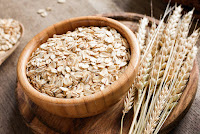A few years ago, I became more concerned about health and fitness as part of my life because I realized that it’s essential to love myself first in order to be calm and strong. One incident made me start thinking seriously about weight loss when I noticed I had gained some weight. One day, I met a colleague at work who gently reminded me about it. That moment made me realize that I didn’t feel good about how I looked.
Yes, I’m sorry to admit that I was affected by society’s views on appearance. I’m totally against body shaming, but I took it personally. I decided that staying fit would be good for my health — and of course, it would also help me feel more confident and stronger.
After becoming more mindful about my health, I started exploring simple changes I could make in my everyday meals. One day, I came across oats — a food I had heard about many times but never really tried seriously. Out of curiosity, I started researching:
What are oats? How are they processed? How can I eat them?
As I began exploring these questions, I found out that oats are not traditionally a staple food in Sri Lanka, India, or most Asian countries. Their origin traces back to Europe — especially Scotland and parts of Western Europe — where they have been cultivated since around 1000 B.C.
Oats became more widely recognized in modern nutrition circles during the 20th century, particularly in the 1980s, when their heart health benefits gained attention due to scientific studies.
“In 1997, the U.S. FDA approved the first health claim for oats - linking oat consumption to a reduced risk of heart disease.”
Oats are a type of whole grain, much like rice, wheat, and millet, which are more familiar to us in South Asia. However, what makes oats stand out is their rich fiber content, especially a type called beta-glucan, which helps manage cholesterol levels and supports heart health. This unique nutritional profile is what makes oats a trendy and healthy alternative — particularly for breakfast or light meals.
Then I found out that oats are processed into three main types: steel-cut oats, rolled oats, and instant oats. Each type differs in texture, cooking time, and how much they are processed.
Steel-cut oats are the least processed form — they are simply whole oat groats that have been chopped into a few pieces. They take longer to cook and have a chewy texture, making them a hearty and filling option.
Rolled oats (also known as old-fashioned oats) are steamed and then flattened with large rollers. This process helps them cook faster while still retaining a good amount of texture and nutrition.
Instant oats are the most processed. They are pre-cooked, dried, and then rolled thinner than rolled oats. As the name suggests, they cook very quickly — just by adding hot water or milk — which makes them convenient for busy mornings, though they may have a softer, mushier texture.
Once I learned about these different types of oats, I decided to go with rolled oats — mainly because they are easily available in the market and offer a good balance of nutrition and convenience.
I went to a supermarket nearby and spent some time reading the labels on various oat products. I compared ingredients, cooking instructions, and even checked for any added sugars or flavors. After going through a few options, I finally chose Kellogg’s rolled oats. It looked clean, simple, and beginner-friendly — just what I needed for my first try.
 |
| My first pick: Kellogg’s Rolled Oats – simple, clean, and beginner-friendly! |
While exploring more about oats, I came across a concern related to an anti-nutrient called phytic acid. Phytic acid is naturally found in many grains, including oats. It has the ability to bind with minerals like iron, zinc, and calcium, which can reduce their absorption in the body.
But this doesn’t mean oats are unhealthy! The good news is that soaking, cooking, or fermenting oats can significantly reduce the phytic acid content and improve the availability of nutrients.
The overnight oats recipe I found on social media surprised me because it contradicted the idea of reducing phytic acid. The recipe seemed simple and convenient — mix oats with water (or milk), and add fruits, nuts, or seeds, then refrigerate overnight. But here’s the concern: Since the oats are not cooked or soaked in water for 4 to 6 hours at room temperature, this method doesn’t offer the opportunity to reduce phytic acid.
Moreover, the temperature in the refrigerator does not suit the activity of the phytase enzyme, which is responsible for breaking down phytic acid. Without proper heat, this enzyme remains inactive, meaning the phytic acid stays in the oats, potentially interfering with nutrient absorption.
To make overnight oats healthier, soak them in warm water or milk for 30 minutes to an hour before refrigerating. Add yogurt to help reduce phytic acid and mix in a little lemon juice or apple cider vinegar to activate the enzyme. If not, cook the oats first and then refrigerate them for a quick breakfast.
After learning more about oats and their benefits, I’ve found that they are a great addition to a healthy diet — whether as overnight oats, porridge, or smoothies. By soaking or cooking oats properly, we can maximize their nutrient value while reducing anti-nutrients like phytic acid.
Now, I feel more confident in making them a regular part of my meals. I encourage you to explore oats for yourself and try different ways of incorporating them into your diet. It's all about finding what works best for your health and lifestyle.
Remember, small changes can lead to big improvements. Here's to a healthier, more balanced future!




No comments:
Post a Comment